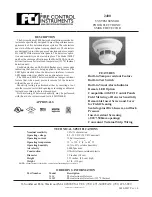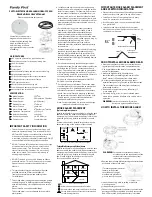
2
Battery compartment
Smoke chamber
Tamper switch
Battery compartment
Smoke chamber
Tamper switch
Battery compartment
Smoke chamber
Ten-years power switch
Battery compartment
Smoke chamber
Ten-years power switch
BACK
Back of SMAZB-141 model
Back of SMAZB-143 model
Back of SCAZB-141 model
Back of SCAZB-143 model
You should know about carbon monoxide
Carbon monoxide, also known as "CO" by the chemical form, is considered to be
a highly dangerous poisonous gas, because it is colorless, odorless or tasteless
and very toxic. In general, biochemistry phenomena have shown that the
presence of CO gas inhibits the blood's capacity to transport oxygen throughout
the body, which can eventually lead to brain damage.
In any enclosed space (home, office, recreational vehicle or boat) even a small
accumulation of CO gas can be quite dangerous.
Although many products of combustion can cause discomfort and adverse
health effects, it is CO gas which presents the greatest threat to life.
Carbon monoxide is produced by the incomplete combustion of fuels such as
natural gas, propane, heating oil, kerosene, coal, charcoal, gasoline, or wood. The
incomplete combustion of fuel can occur in any device which depends on
burning for energy or heat such as furnaces, boilers, room heaters, hot water
heaters, stoves, grills, and in any gasoline powered vehicle or engine (e.g.
generator set, lawnmower). Tobacco smoke also adds CO to the air you breathe.
When properly installed and maintained, your natural gas furnace and hot water
heater do not pollute your air space with CO. Natural gas is known as a "clean
burning" fuel because under correct operating conditions, the combustion
products are water vapor and carbon dioxide (CO2), which is not toxic. The
products of combustion are exhausted from furnaces and water heaters to the
outside by means of a fuel duct or chimney.
Correct operation of any burning equipment requires two key conditions:
• An adequate supply of air for complete combustion.
•
Proper venting of the products of combustion from the furnace through the
chimney, vent or duct to the outside.
Typical carbon monoxide gas problems are summarized here:
•
Equipment problems, due to defects, poor maintenance, damaged and
cracked heat exchangers.
•
Collapsed or blocked chimneys or flues, dislodged, disconnected or damaged
vents
Possible symptoms of carbon monoxide poisoning
Carbon monoxide is colorless, odorless, tasteless, and very toxic. When inhaled,
it produces an effect known as chemical asphyxiation. Injury is due to the
combining of CO with the available hemoglobin in the blood, lowering the
oxygen-carrying capacity of the blood. In the presence of CO gas, the body is
quickly affected by oxygen starvation.
The following symptoms are related to CO poisoning and should be discussed
with all members of the household so that you know what to look for:
• Extreme exposure: unconsciousness, convulsions, cardio- respiratory failure,
death.
•
Medium exposure: severe throbbing headache, drowsiness, confusion,
vomiting, fast heart rate.
•
Mild exposure: slight headache, nausea, fatigue (similar to "flu-like"
symptoms).
Many victims of carbon monoxide poisoning indicate that while they were aware
that they were ill, they became so disoriented and confused that they were
unable to help themselves by either exiting the building or calling for a
assistance. Young children and household pets may be the first affected.
Exposure during sleep is particularly dangerous, because the victim usually does
not awaken.
Situation of smoke alarm not be effective
The various situations against which the smoke alarm may not be effective, for
example:
1. Fires where the victim is intimate with a flaming initiated fire; for example,
when a person’s clothes catch fire while cooking;
2. Fires where the smoke is prevented from reaching the smoke alarm due to a
closed door or other obstruction;
3. Incendiary fires where the fire grows so rapidly that an occupant’s egress is
blocked even with properly located smoke alarms.
Locations to install your detector
FOR CO DETECTOR
Since CO gas moves freely in the air, the suggested location is in or as near as
possible to sleeping areas of the home. The human body is most vulnerable to
the effects of CO gas during sleeping hours. For maximum protection, a CO
detector should be located outside primary sleeping areas or on each level of
your home. The electrochemical sensor detects carbon monoxide, measures the
concentration and sounds a loud alarm before a potentially harmful level is
reached.
Figure 1:
Location for placing
CO detectors for a multi-floor
residence
CAUTION:
This alarm is only intended to be ceiling mounted or no more than 12
inches below the ceiling.
CAUTION:
This alarm will only indicate the presence of carbon monoxide gas at
the sensor. Carbon monoxide gas may be present in other areas.
CAUTION:
The user shall actuate the test and/ or alarm reset/silence feature
remotely (via an electronic signal or aerosol test gas), or by use of a person’s
finger or thumb, and that the use of any other instrument(s) is strictly prohibited.
•
Downdraft in chimneys or flues. This can be caused by very long or circuitous
flue runs, improper location of flue exhaust or wind conditions
•
Improper installation or operation of equipment, chimney or vents
•
Air tightness of house envelop/inadequate combustion of air
•
Inadequate exhaust of space heaters or appliances
•
Exhaust ventilation/fireplace competing for air supply.
Potential sources of carbon monoxide in your home or office include clogged
chimney, wood stove, wood or gas fireplace, automobile and garage, gas water
heater, gas appliance, gas or kerosene heater, gas or oil furnace, and cigarette
smoke.
This product is intended for use in ordinary indoor locations of family living units. It
is not designed to measure compliance with Occupational Safety and Health
Administration (OSHA) commercial or industrial standards. OSHA has established
that continuous exposure levels of 50ppm should not be exceeded in an 8 hour
period. Individuals with a medical problem may consider using warning devices
which provide audible and visual signals for carbon monoxide concentrations
under 30ppm.
Smoke detectors should be installed in accordance with the NFPA Standard 72
(National Fire Protection Association, Batterymarch Park, Quincy, MA 02169). For
complete coverage in residential units, smoke detectors should be installed in all
rooms, halls, storage areas, basements, and attics in each family living unit.
Minimum coverage is one detector on each floor and one in each sleeping area.
Here, we have useful tips for you:
Install one separate smoke detector in every bedroom and one smoke detector
in the floor as a minimum protection. Install one separate smoke detector in
every room, except kitchen and bathroom for more security, as shown in Figure
2 and Figure 3.
Install a smoke detector on every floor of a multi-floor home or apartment, as
shown in Figure 4.
Install a smoke detector inside every bedroom.
Install smoke detectors at both ends of a bedroom hallway if the hallway is
more than 40 feet (12 meters) long.
The detector is not to be located within 5 feet (1.5m) of any cooking appliance.
In damp or very humid areas, or near bathrooms with showers. Moisture in
humid air can enter the sensing chamber, then turns into droplets upon cooling,
which can cause nuisance alarms. Install smoke detectors at least 10 feet (3
meters) away from bathrooms.
In very cold or very hot areas, including unheated buildings or outdoor rooms.
If the temperature goes above or below the operating range of smoke detector,
it will not work properly. The temperature range for your smoke detector is 40
to 100 F (4.4 C to 37.8 C).
In very dusty or dirty areas, dirt and dust can build up on the detector’s sensing
chamber, to make it overly sensitive. Additionally, dust or dirt can block
openings to the sensing chamber and keep the detector from sensing smoke.
Near fresh air vents or very drafty areas like air conditioners, heaters or fans,
fresh air vents and drafts can drive smoke away from smoke detectors.
Dead air spaces are often at the top of a peaked roof, or in the corners between
ceilings and walls. Dead air may prevent smoke from reaching a detector. See
Figures 5 and 6 for recommended mounting locations.
In insect-infested areas. If insects enter a detector’s sensing chamber, they may
cause a nuisance alarm. Where bugs are a problem, get rid of them before
putting up a detector.
Near fluorescent lights, electrical “noise” from fluorescent lights may cause
nuisance alarms. Install smoke detectors at least 5 feet (1.5 meters) from such
lights.
Your smoke detector is not to be used with smoke alarm guards.
























